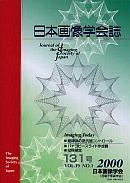Volume 52, Issue 6
Displaying 1-15 of 15 articles from this issue
- |<
- <
- 1
- >
- >|
Original Paper
-
2013Volume 52Issue 6 Pages 484-487
Published: December 10, 2013
Released on J-STAGE: December 13, 2013
Download PDF (551K) -
2013Volume 52Issue 6 Pages 488-493
Published: December 10, 2013
Released on J-STAGE: December 13, 2013
Download PDF (2074K)
Invited Paper
-
2013Volume 52Issue 6 Pages 495-500
Published: December 10, 2013
Released on J-STAGE: December 13, 2013
Download PDF (2536K) -
2013Volume 52Issue 6 Pages 501-508
Published: December 10, 2013
Released on J-STAGE: December 13, 2013
Download PDF (1544K) -
2013Volume 52Issue 6 Pages 509-514
Published: December 10, 2013
Released on J-STAGE: December 13, 2013
Download PDF (954K) -
2013Volume 52Issue 6 Pages 515-522
Published: December 10, 2013
Released on J-STAGE: December 13, 2013
Download PDF (1516K) -
2013Volume 52Issue 6 Pages 523-529
Published: December 10, 2013
Released on J-STAGE: December 13, 2013
Download PDF (934K) -
2013Volume 52Issue 6 Pages 530-534
Published: December 10, 2013
Released on J-STAGE: December 13, 2013
Download PDF (860K) -
2013Volume 52Issue 6 Pages 535-541
Published: December 10, 2013
Released on J-STAGE: December 13, 2013
Download PDF (1092K)
Invited Review
-
2013Volume 52Issue 6 Pages 542-546
Published: December 10, 2013
Released on J-STAGE: December 13, 2013
Download PDF (1550K) -
2013Volume 52Issue 6 Pages 547-554
Published: December 10, 2013
Released on J-STAGE: December 13, 2013
Download PDF (2047K) -
2013Volume 52Issue 6 Pages 555-560
Published: December 10, 2013
Released on J-STAGE: December 13, 2013
Download PDF (1639K) -
2013Volume 52Issue 6 Pages 561-566
Published: December 10, 2013
Released on J-STAGE: December 13, 2013
Download PDF (1560K) -
2013Volume 52Issue 6 Pages 567-574
Published: December 10, 2013
Released on J-STAGE: December 13, 2013
Download PDF (1303K)
Lectures in Science
-
2013Volume 52Issue 6 Pages 575-580
Published: December 10, 2013
Released on J-STAGE: December 13, 2013
Download PDF (1156K)
- |<
- <
- 1
- >
- >|
